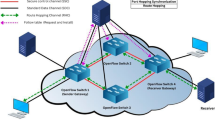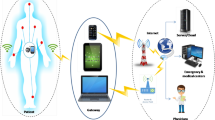Abstract
In most Wireless Sensor Network (WSN) applications the sensor nodes forward their measurements to a central base station (BS). The unique role of the BS makes it a natural target for an adversary’s attack. Even if a WSN employs conventional security mechanisms such as encryption and authentication, an adversary may apply traffic analysis techniques to locate the BS. This motivates a significant need for improved BS anonymity to protect the identity, role, and location of the BS. Previous work presented distributed beamforming as a very effective anonymity-boosting technique. However, such work assumed that the adversary is unaware of the countermeasure, and thus the anonymity performance could be unattainable. In this paper we extend our preliminary work from Ward and Younis (Proceedings of the IEEE military communications conference (MILCOM 2016), Baltimore, MD, 2016) to show that the adversary could adapt the attack strategy when knowing of the use of distributed beamforming. We analyze two strategies for such an adaptive attack, one using Evidence Theory and one using Traffic Volume. We then develop a cross-layer countermeasure that incorporates distributed beamforming to successfully misdirect such an adaptive adversary and boost BS anonymity. The effectiveness of our approach is validated through simulation.













Similar content being viewed by others
References
Karl, H., & Willig, A. (2005). Protocols and architectures for wireless sensor networks. New York: Wiley.
Yick, J., Mukherjee, B., & Ghosal, D. (2008). Wireless sensor network survey. Computer Networks, 52(12), 2292–2330.
Perrig, A., Szewczyk, R., Wen, V., Culler, D., & Tygar, D. (2002). SPINS: Security protocols for sensor networks. Wireless Networks, 8(5), 521–534.
Li, N., Zhang, N., Das, S. K., & Thuraisingham, B. (2009). Privacy preservation in wireless sensor networks: A state-of-the-art survey. Ad Hoc Networks, 7(8), 1501–1514.
Seys, S., & Preneel, B. (2006, April). ARM: Anonymous routing protocol for mobile ad hoc networks. In Proceedings of the 20th IEEE Conferences on Advanced Information Networking and Applications, Vienna, Austria.
Wang, J., Wang, F., Cao, Z., Lin, F., & Wu, J. (2017). Sink location privacy protection under direction attack in wireless sensor networks. Wireless Networks, 23(2), 579–591.
Kong, J., Xiaoyan, H., & Gerla, M. (2007). An identity-free and on-demand routing scheme against anonymity threats in mobile ad hoc networks. IEEE Transactions on Mobile Computing, 6(8), 888–902.
Sheu, J.-P., Jiang, C., & Deng, J. (2010, June). An anonymous path routing (APR) protocol for wireless sensor networks. In Proceedings of the IEEE International Conference on Wireless Communications Networking and Information Security (WCNIS 2010), Beijing, China.
Acharya, U., & Younis, M. (2010). Increasing base-station anonymity in wireless sensor networks. Journal of Ad-hoc Network, 8(8), 791–809.
Huang, D. (2006, November). On measuring anonymity for wireless mobile ad-hoc networks. In Proceedings of the IEEE Conferences on Local Computer Networks (LCN 2006), Tampa, FL.
Ward, J. R., & Younis, M. (2015). Increasing base station anonymity using distributed beamforming. Ad Hoc Networks, 32, 53–80.
Mudumbai, R., Barriac, G., & Madhow, U. (2007). On the feasibility of distributed beamforming in wireless networks. IEEE Transactions on Wireless Communications, 6(5), 1754–1763.
Ward, J. R., & Younis, M. (2016, November) A cross-layer traffic analysis countermeasure against adaptive attackers of wireless sensor networks. In Proceedings of the IEEE Military Communications Conference (MILCOM 2016), Baltimore, MD.
Mudumbai, R., Brown, D. R., Madhow, U., & Poor, H. V. (2009). Distributed transmit beamforming: Challenges and recent progress. IEEE Communications Magazine, 47(2), 102–110.
Mudumbai, R., Barriac, G., & Madhow, U. (2007). On the feasibility of distributed beamforming in wireless networks. IEEE Transactions on Wireless Communications, 6(5), 1754–1763.
Quintin, F., Rahman, M. M. U., Mudumbai, R., & Madhow, U. (2013). A scalable architecture for distributed transmit beamforming with commodity radios: Design and proof of concept. IEEE Transactions on Wireless Communications, 12(3), 1418–1428.
Rahman, M. M., Baidoo-Williams, H. E., Mudumbai, R., & Dasgupta, S. (2012, April). Fully wireless implementation of distributed beamforming on a software-defined radio platform. In Proceedings of the 11th ACM/IEEE Conference on Information Processing in Sensor Networks (IPSN ‘12), Beijing, China.
Oh, S., Vu, T., Gruteser, M., & Banerjee, S. (2012, March). Phantom: Physical layer cooperation for location privacy protection. In Proceedings of 31st Annual IEEE International Conference on Computer Communications (INFOCOM 2012), Orlando, FL.
Baroutis, N., & Younis, M. (2015, November). Using fake sinks and deceptive relays to boost base-station anonymity in wireless sensor networks. In Proceedings of the IEEE Conferences on Local Computer Networks (LCN 2015), Tampa, FL.
Mahmoud, M., & Shen, X. (2012). Cloud-based scheme for protecting source location privacy against hotspot-locating attack in wireless sensor networks. IEEE Transactions on Parallel and Distributed Systems, 23(10), 1805–1818.
Bradbury, M., Jhumka, A., & Leeke, M. (2018). Hybrid online protocols for source location privacy in wireless sensor networks. Journal of Parallel & Distributed Computing, 115, 67–81.
Shao, M., Yang, Y., Zhu, S., & Cao, G. (2008, April). Towards statistically strong source anonymity for sensor networks. In Proceedings of the IEEE Information Communications Conference (INFOCOM’08), Phoenix, AZ.
Kamat, P., Zhang, Y., Trappe, W., & Ozturk, C. (2005, June). Enhancing source location privacy in sensor network routing. In Proceedings of the International Conference on Distributed Computing Systems (ICDCS ’05), Columbus, OH.
Ouyang, Y., Le, Z., Chen, G., Ford, J., & Makedon, F. (2006, June). Entrapping adversaries for source protection in sensor networks. In Proceedings of the International Conference on World of Wireless, Mobile, and Multimedia Networking (WoWMoM ’06), Buffalo, NY.
Ozturk, C., Zhang, Y., & Trappe, W. (2004, October). Source-location privacy in energy constrained sensor network routing. In Proceedings of the Workshop on Security of Ad Hoc and Sensor Networks (SASN ’04), Washington, DC.
Mehta, K., Liu, D., & Wright, M. (2007, October). Location privacy in sensor networks against a global eavesdropper. In Proceedings of the IEEE International Conference on Network Protocols (ICNP), Beijing, China.
Rios, R., & Lopez, J. (2011). Analysis of location privacy solutions in wireless sensor network. IET Communications, 5(17), 2518–2532.
Bradbury, M., & Jhumka, A. (2017, August). A near-optimal source location privacy scheme for wireless sensor networks. In Proceedings of the 16th IEEE International Conference on Trust, Security and Privacy in Computing and Communications (TRUSTCOM’17), Sydney, Australia.
Shao, M., Hu, W., Zhu, S., Cao, G., Krishnamurth, S., & La Porta, T. (2009, June). Cross-layer enhanced source location privacy in sensor networks. In Proceedings of the IEEE Communications Society Conference on Sensor, Mesh and Ad Hoc Communications and Networks (SECON 2009), Rome, Italy.
Wang, N., Fu, J., Zeng, J., & Bhargava, B. (2018). Source-location privacy full protection in wireless sensor networks. Information Sciences, 444, 105–121.
Manjula, R., & Datta, R. (2018). A novel source location privacy preservation technique to achieve enhanced privacy and network lifetime in WSNs. Computer Networks, 44, 58–73.
Proaño, A., et al. (2017). Traffic decorrelation techniques for countering a global eavesdropper in WSNs. IEEE Transactions on Mobile Computing, 16(3), 857–871.
Lee, S., Kim, J., & Kim, Y. (2016). Preserving source- and sink-location privacy in sensor networks. Computer Science and Information Systems, 13(1), 115–130.
Mehta, K., Liu, D., & Wright, M. (2012). Protecting location privacy in sensor networks against a global eavesdropper. IEEE Transactions on Mobile Computing, 11(2), 320–336.
Kumar, V., Kumar, A., & Singh, M. (2017, September). Boosting anonymity in wireless sensor networks. In Proceedings of the 4th International Conference on Signal Processing, Computing, and Control (ISPCC 2017), India.
Ebrahimi, Y., & Younis, M. (2011, July). Using deceptive packets to increase base-station anonymity in wireless sensor networks. In Proceedings of the Wireless Communications and Mobile Computing Conference (IWCMC’11), Istanbul, Turkey.
Alsemairi, S., & Younis, M. (2016, April). Forming a cluster-mesh topology to boost base -station anonymity in wireless sensor networks. In Proceedings of the IEEE on Wireless Communications and Networking Conference (WCNC 2016), Doha, Qatar.
Bangash, Y., Zeng, L., & Feng, D. (2017). MimiBS: Mimicking base-station to provide location privacy protection in wireless sensor networks. Journal of Computer Science and Technology, 32(5), 991–1007.
Alsemairi, S., & Younis, M. (2015, December). Clustering-based mitigation of anonymity attacks in wireless sensor networks. In Proceedings of the IEEE on Global Communications Conference (GLOBECOM 2015), San Diego, CA.
Conner, W., Abdelzaher, T., & Nahrstedt, K. (2006, June). Using data aggregation to prevent traffic analysis in wireless sensor networks. In Proceedings of the International Conference on Distributed Computing in Sensor Systems (DCOSS’06) Springer-Verlag, LNCS 4026.
Ying, D., Makrakis, D., & Mouftah, H. T. (2014). Anti-traffic analysis attack for location privacy in WSNs. EURASIP Journal on Wireless Communications and Networking, 2014, 131.
Deng, J., Han, R., & Mishra, S. (2006). Decorrelating wireless sensor network traffic to inhibit traffic analysis attacks. Pervasive and Mobile Computing Journal, 2, 159–186.
Deng, J., Han, R., & Mishra, S. (2005, September). Countermeasures against traffic analysis attacks in wireless sensor networks. In Proceedings of the 1st International Conference on Security and privacy for Emerging Areas in Communication Networks (SECURECOMM ‘05), Athens, Greece.
Chen, J., Lin, Z., Liu, Y., Hu, Y., & Du, X. (2016). Sink location protection protocols based on packet sending rate adjustment. International Journal of Distributed Sensor Networks, 2016, Article ID 6354514.
Jian, Y., Chen, S., Zhang, Z., & Zhang, L. (2008). A novel scheme for protecting receiver’s location privacy in wireless sensor networks. IEEE Transactions on Wireless Communications, 7(10), 3769–3779.
Rios, R., et al. (2015). Probabilistic receiver-location privacy protection in wireless sensor networks. Information Sciences, 321, 205–223.
Lightfoot, L., & Ren, J. (2015, June). R-STaR destination-location privacy schemes in wireless sensor networks. In Proceedings of the IEEE International Conference on Communications (ICC 2015), London.
Ebrahimi, Y., & Younis, M. (2011, June). Increasing transmission power for higher base-station anonymity in wireless sensor network. In Proceedings of the IEEE International Conference on Communications (ICC 2011), Kyoto, Japan.
Ngai, E. C. H., & Rodhe, I. (2013). On providing location privacy for mobile sinks in wireless sensor networks. ACM/Springer Wireless Networks, 19, 115–130.
Ward, J. R., & Younis, M. (2016, August). Distributed beamforming relay selection to increase base station anonymity in WSNs. In Proceedings of the International Conference on Computer Communication and Networks (ICCCN 2016), Waikoloa, HI.
Ganeriwal, S., Kumar, R., & Srivastava, M. B. (2003, November). Timing-sync protocol for sensor networks. In Proceedings of the 1st ACM International Conference on Embedded Networked Sensor Systems (SenSys 2003), Los Angeles, CA.
Elson, J., Girod, L., & Estrin, D. (2002, December). Fine-grained network time synchronization using reference broadcasts. In Proceedings of the 5th Symposium on Operating Systems Design and Implementation (OSDI 2002), Boston, MA.
Ward, J. R., & Younis, M. (2015, December). An energy-efficient cross-layer routing approach for wireless sensor networks using distributed beamforming. In Proceedings of the IEEE Global Communications Conference (Globecom 2015), San Diego, CA.
Baroutis, N., & Younis, M. (2017). Load-conscious maximization of base-station location privacy in wireless sensor networks. Computer Networks, 124, 126–139.
Ying, D., Makrakis, D., & Mouftah, H. T. (2014). Anti-traffic analysis attack for location privacy in WSNs. EURASIP Journal on Wireless Communications and Networking, 2014, 131.
Author information
Authors and Affiliations
Corresponding author
Ethics declarations
Competing interests
The authors declare that they have no competing interests.
Additional information
Publisher's Note
Springer Nature remains neutral with regard to jurisdictional claims in published maps and institutional affiliations.
Rights and permissions
About this article
Cite this article
Ward, J.R., Younis, M. Cross-layer traffic analysis countermeasures against adaptive attackers of wireless sensor networks. Wireless Netw 25, 2869–2887 (2019). https://doi.org/10.1007/s11276-019-02003-9
Published:
Issue Date:
DOI: https://doi.org/10.1007/s11276-019-02003-9




